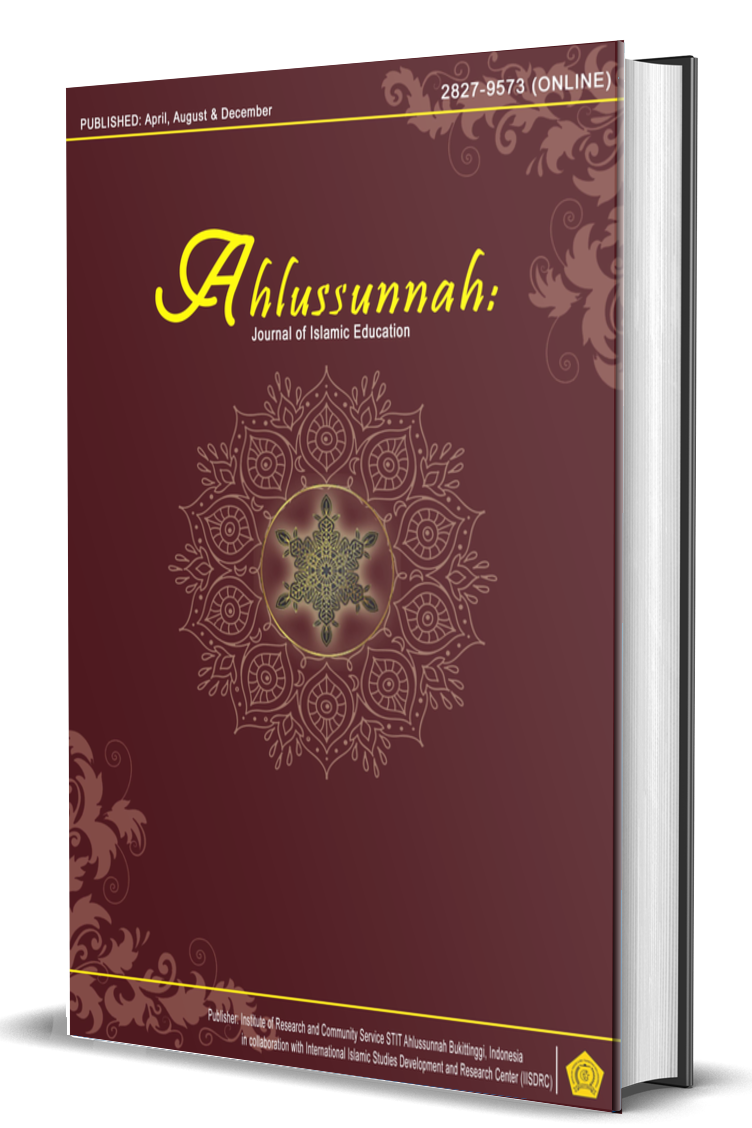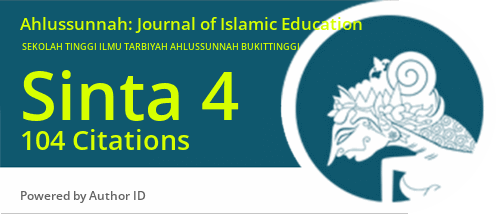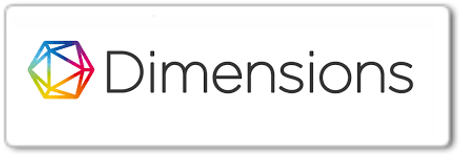Problems of the Quran Learning Process During the Covid-19 Pandemic
DOI:
https://doi.org/10.58485/jie.v1i2.83Keywords:
Learning strategies, tajwid science, Covid-19 pandemicAbstract
The author's background in conducting this research is because there is a phenomenon that has occurred since the COVID-19 pandemic in the Quran Education teacher strategies have not varied in preparing learning to read the Quran since the covid-19 pandemic, there have been many mistakes made by students in applying tajwid knowledge when reading the Quran, and there have been obstacles in the learning process during covid-19 resulting in learning dynamics both on the part of teachers and students. This research aims to determine the implementation of learning strategies to read the Quran since the COVID-19 pandemic and to find out the obstacles to implementing learning strategies to read the Quran since the COVID-19 pandemic. This type of research uses field research, which is a form of research intended to describe phenomena. Phenomena that exist in the field, whether natural phenomena or human engineering. The object of this research is the implementation of teacher strategies in learning to read the koran since the COVID-19 pandemic. Data collection techniques include interviews, observation, and documentation. The obstacle from parents is that they don't agree with online learning because they don't have the money to buy a package and the network is often lost.
Downloads
References
Adair, J. K., Colegrove, K. S.-S., & McManus, M. E. (2017). How the Word Gap Argument Negatively Impacts Young Children of Latinx Immigrants’ Conceptualizations of Learning. Harvard Educational Review, 87(3), 309–334. https://doi.org/10.17763/1943-5045-87.3.309
Anugrah, M., & Mu’alim, M. (2022). Mathematics Practicum-Based Learning to Improve Critical Thinking Skills for Fourth Grade Students at Madrasah Ibtidaiyah. Thinking Skills and Creativity Journal, 5(1), 7–11. https://doi.org/10.23887/tscj.v5i1.35968
Bianco, A., Cheng, H. M., Enoki, T., Gogotsi, Y., Hurt, R. H., Koratkar, N., Kyotani, T., Monthioux, M., Park, C. R., Tascon, J. M. D., & Zhang, J. (2013). All in the graphene family - A recommended nomenclature for two-dimensional carbon materials. Carbon, 65, 1–6. https://doi.org/10.1016/j.carbon.2013.08.038
Clark, M. (2013). The politics of heritage: Indonesia-Malaysia cultural contestations. Indonesia and the Malay World, 41(121), 396–417. https://doi.org/10.1080/13639811.2013.804979
Crawford, J., Butler-Henderson, K., Rudolph, J., Malkawi, B., Glowatz, M., Burton, R., Magni, P. A., & Lam, S. (2020). COVID-19: 20 countries’ higher education intra-period digital pedagogy responses. Journal of Applied Learning and Teaching, 3(1), 09–28. https://doi.org/10.37074/jalt.2020.3.1.7
du Plessis, P., & Mestry, R. (2019). Teachers for rural schools – A challenge for South Africa. South African Journal of Education, 39. https://doi.org/10.15700/saje.v39ns1a1774
Ehri, L. C. (2014). Orthographic Mapping in the Acquisition of Sight Word Reading, Spelling Memory, and Vocabulary Learning. Scientific Studies of Reading, 18(1), 5–21. https://doi.org/10.1080/10888438.2013.819356
Fitriani, F., Lestari, Y., Japeri, J., Namira, S., Engkizar, E., & Anwar, F. (2021). Strategi Guru Dalam Mendidik Akhlak Peserta Didik Di Sekolah Dasar. Muallimuna: Jurnal Madrasah Ibtidaiyah, 8(1), 13–29. https://doi.org/10.31602/muallimuna.v8i1.6161.
Gent, B., & Muhammad, A. (2019). Memorising and reciting a text without understanding its meaning: A multi-faceted consideration of this practice with particular reference to the Qur’an. Religions, 10(7). https://doi.org/10.3390/rel10070425
Gherheș, V., Stoian, C. E., Fărcașiu, M. A., & Stanici, M. (2021). E-learning vs. Face-to-face learning: Analyzing students’ preferences and behaviors. Sustainability (Switzerland), 13(8). https://doi.org/10.3390/su13084381
Gikas, J., & Grant, M. M. (2013). Mobile computing devices in higher education: Student perspectives on learning with cellphones, smartphones & social media. Internet and Higher Education, 19, 18–26. https://doi.org/10.1016/j.iheduc.2013.06.002
Gilli, A., & Gilli, M. (2016). The Diffusion of Drone Warfare? Industrial, Organizational, and Infrastructural Constraints. Security Studies, 25(1), 50–84. https://doi.org/10.1080/09636412.2016.1134189
González, S., & Bonal, X. (2021). COVID-19 school closures and cumulative disadvantage: Assessing the learning gap in formal, informal and non-formal education. European Journal of Education, 56(4), 607–622. https://doi.org/10.1111/ejed.12476
Hefner, R. W. (2021). Islam and institutional religious freedom in indonesia. Religions, 12(6). https://doi.org/10.3390/rel12060415
Khaidir, E., & Suud, F. M. (2020). Islamic Education in Forming Students’ Characters At As-Shofa Islamic High School, Pekanbaru Riau. International Journal of Islamic Educational Psychology (IJIEP), 1(1). https://doi.org/10.18196/ijiep.1105
Kirkwood, A., & Price, L. (2013). Examining some assumptions and limitations of research on the effects of emerging technologies for teaching and learning in higher education. British Journal of Educational Technology, 44(4), 536–543. https://doi.org/10.1111/bjet.12049
Läänemets, U., Kalamees-Ruubel, K., Kiilu, K., & Sepp, A. (2018). Curriculum Development Considering Formal, Non-Formal and Informal Education. SOCIETY. INTEGRATION. EDUCATION. Proceedings of the International Scientific Conference, 2, 286–295. https://doi.org/10.17770/sie2018vol1.3182
Marchand, G. C., & Gutierrez, A. P. (2012). The role of emotion in the learning process: Comparisons between online and face-to-face learning settings. Internet and Higher Education, 15(3), 150–160. https://doi.org/10.1016/j.iheduc.2011.10.001
Moldan, B., Janoušková, S., & Hák, T. (2012). How to understand and measure environmental sustainability: Indicators and targets. Ecological Indicators, 17, 4–13. https://doi.org/10.1016/j.ecolind.2011.04.033
Munastiwi, E. (2021). Adaptation of Teaching-Learning Models Due to Covid-19 Pandemic: Challenge Towards Teachers Problem-Solving Skills. Jurnal Ilmiah Sekolah Dasar, 5(1), 33. https://doi.org/10.23887/jisd.v5i1.32695
Murniyetti, M., Engkizar, E., & Anwar, F. (2016). Pola Pelaksanaan Pendidikan Karakter Terhadap Siswa Sekolah Dasar. Jurnal Pendidikan Karakter, 7(2). https://doi.org/10.21831/jpk.v6i2.12045
Mutisya, D. N., & Makokha, G. L. (2016). Challenges affecting adoption of e-learning in public universities in Kenya. E-Learning and Digital Media, 13(3–4), 140–157. https://doi.org/10.1177/2042753016672902
Nagy, W., Townsend, D., Lesaux, N., & Schmitt, N. (2012). Words as tools: Learning academic vocabulary as language acquisition. Reading Research Quarterly, 47(1), 91–108. https://doi.org/10.1002/RRQ.011
Pendidikan Islam, J., Kaputra, S., Akyuni, Q., Rahawarin, Y., Safarudin, R., Pattimura, U., & Tinggi Agama Islam Yayasan Kebangkitan Islam Sumatera Barat, S. (2021). Dampak Pendidikan Orang Tua Terhadap Kebiasaan Religius Anak Dalam Keluarga Jama’Ah Tabligh. Al-Tadzkiyyah: Jurnal Pendidikan Islam, 12(2), 249–268. https://doi.org/10.24042/atjpi.v12i2.9979.
Phillippi, J., & Lauderdale, J. (2018). A Guide to Field Notes for Qualitative Research: Context and Conversation. Qualitative Health Research, 28(3), 381–388. https://doi.org/10.1177/1049732317697102
Romi, S., & Schmida, M. (2009). Non-formal education: A major educational force in the postmodern era. Cambridge Journal of Education, 39(2), 257–273. https://doi.org/10.1080/03057640902904472
Sari, W., Anwar, F., Wirdati, W., & Engkizar, E. (2022). Metode Diskusi Guru Pendidikan Agama Islam dalam Meningkatkan Kepercayaan Diri Peserta Didik. Jurnal Pendidikan Tambusai, 5(3), 8904–8909.
Supriadi, U., Supriyadi, T., & Abdussalam, A. (2022). Al-Qur’an Literacy: A Strategy and Learning Steps in Improving Al-Qur’an Reading Skills through Action Research. International Journal of Learning, Teaching and Educational Research, 21(1), 323–339. https://doi.org/10.26803/ijlter.21.1.18
Sutejo, E., Nurdin, N., & Syahid, A. (2021). The Implementation of Islamic Education in Building Preprimary Disabled Students Character. International Journal of Contemporary Islamic Education, 3(2), 41–58. https://doi.org/10.24239/ijcied.vol3.iss2.38
Tang, Y. M., Chen, P. C., Law, K. M. Y., Wu, C. H., Lau, Y. yip, Guan, J., He, D., & Ho, G. T. S. (2021). Comparative analysis of Student’s live online learning readiness during the coronavirus (COVID-19) pandemic in the higher education sector. Computers and Education, 168. https://doi.org/10.1016/j.compedu.2021.104211
van Driel, J. (2021). Developing Science Teachers’ Pedagogical Content Knowledge. Science Teachers’ Knowledge Development, 1–37. https://doi.org/10.1163/9789004505452_001
Warsito, E. (2022). Character Education Construction For Students At The Islamic Boarding School (A Case Study At Khoirul Huda Surabaya College Student Islamic Boarding School). Inovasi-Jurnal Diklat Keagamaan, 16(1), 21–29. https://doi.org/10.52048/inovasi.v16i1.276
Watson, C. (2014). Effective professional learning communities? the possibilities for teachers as agents of change in schools. British Educational Research Journal, 40(1), 18–29. https://doi.org/10.1002/berj.3025
Downloads
Published
How to Cite
Issue
Section
License
Copyright (c) 2022 Ratna Azizah, Iswantir M, Guslianto Guslianto

This work is licensed under a Creative Commons Attribution-ShareAlike 4.0 International License.
Creative Commons Attribution 4.0 (CC BY)











